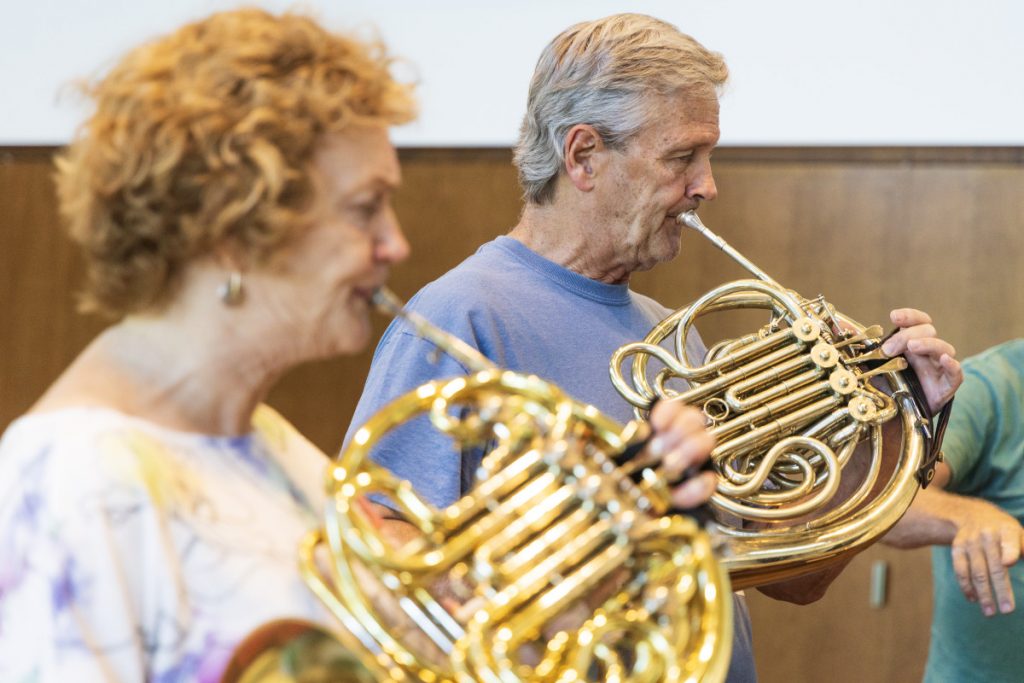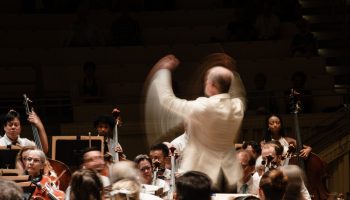
The Chautauqua Symphony Orchestra performs Tchaikovsky’s Symphony No. 4 under the baton of Music Director and Principal Symphonic Conductor Rossen Milanov Tuesday in the Amphitheater.
The five French horn players of the Chautauqua Symphony Orchestra have a real bond, said Donna Dolson — who, with Roger Kaza, Bill Bernatis, Daniel Kerdelewicz and Mark Robbins — will be a featured soloist on this evening’s CSO program, specifically designed to showcase the “beautiful tone” of the French horn that speaks to its “soulful quality,” as principal French horn Kaza described Robert Schumann’s Konzertstück for Four Horns and Orchestra.

Chautauqua Symphony Orchestra French horn players Donna Dolson and William Bernatis rehearse Monday in the Amp.
While written for four French horns, the Schumann has been adapted for this evening by Kaza himself, so he could “spread out the glory and the pain” to all five musicians.
“The whole Romantic movement was into the sublime and the grotesque and just extreme emotions. So (Schumann) felt a kinship with a horn as a quintessentially Romantic instrument,” Kaza said. “… Schumann was a big fan of the horn, more than other instruments, and so we’re very grateful for that.”
Schumann’s Concert Piece Op. 86 is one of four pieces the CSO will perform at 8:15 p.m. tonight in the Amphitheater, led by Principal Symphonic Conductor and Music Director Rossen Milanov.
As well as Schumann’s piece featuring the horns, the evening will include Strauss’ “Carnival of Venice Fantasy,” Bizet’s Symphony in C, and Offenbach’s Orpheus in the Underworld Overture.
Principal horn in both the St. Louis Symphony and the CSO, Kaza grew up well-acquainted with music as both his mother and father were professional musicians. He attended all his father’s concerts with the Oregon Symphony and learned the whole “old symphonic repertoire” by the time he was 13 or so.
Bernatis is principal horn with the Las Vegas Philharmonic; Dolson was recruited for principal horn in Osaka Century Orchestra; Kerdelewicz is associate principal horn of the Buffalo Philharmonic Orchestra; and Robbins is associate principal horn at the Seattle Symphony — most teach in some aspect as well, as professors or in masterclass settings.
Schumann is said to have had bipolar personality disorder, which resulted in frenzied production periods: he is purported to have constructed Op. 86 in three days. That energy is palpable.
“There’s something very soulful and heartfelt about Schumann; when he’s at his best he feels like — even across time and space — he’s speaking directly to you, one soul to another,” Kaza said. “He’s just very vulnerable; he doesn’t have any walls up. You can kind of sense the fragility of his psyche.”
Schumann’s ambition and imagination led him to write some incredibly challenging horn parts, almost immediately after valves were invented for the horn to include a full scale; reportedly, the first performance of Op. 86 was a complete disaster because the players weren’t up to the challenge. (When he was just starting on the French horn, Robbins said, he thought Schumann would be impossible to play because of this.)
But that’s also what makes Schumann inspiring, “because of his quintessential Romantic spirit and the idea that there’s a muse that you can follow on a whim which will lead to something incredibly new, fresh, and heartfelt,” Kaza said. “This was not the classical model of trying to be very cool and structured. Schumann harnessed that energy towards his creativity and you hear a lot of that mania in this piece.”
Dolson described Op. 86 as virtuosic and legato: technical and smooth in construction. Not only is the piece challenging technically, but musicians have to think about the weather as well, as brass and woodwinds tend to be flat when cold.
“This is a group of high-caliber musicians — rehearsal, concert, rehearsal, concert — so you really have to be on your toes. It’s never boring here,” Dolson said. “So (what makes this orchestra so fantastic is) the caliber of the players and the joy of playing this great repertoire every summer. Everyone looks forward to coming back here.”
Being a part of the CSO has provided a strong sense of community for Kaza and is one of the most important aspects of Chautauqua to him. For example, the CSO has volleyball parties every week, and the social aspect is undeniably part of what keeps musicians coming back.
“There aren’t too many places that have the kind of all-encompassing cultural milieu that Chautauqua has,” Kaza said. “It is almost impossible to describe Chautauqua, because there’s nothing else like it. I didn’t know what to make of Chautauqua at first; it’s taken a while to completely understand it. I just find it to be the best group of people. The orchestra is incredibly warm, friendly, and social. It’s just like a whole aspect of my social life that I look forward to every year.”




